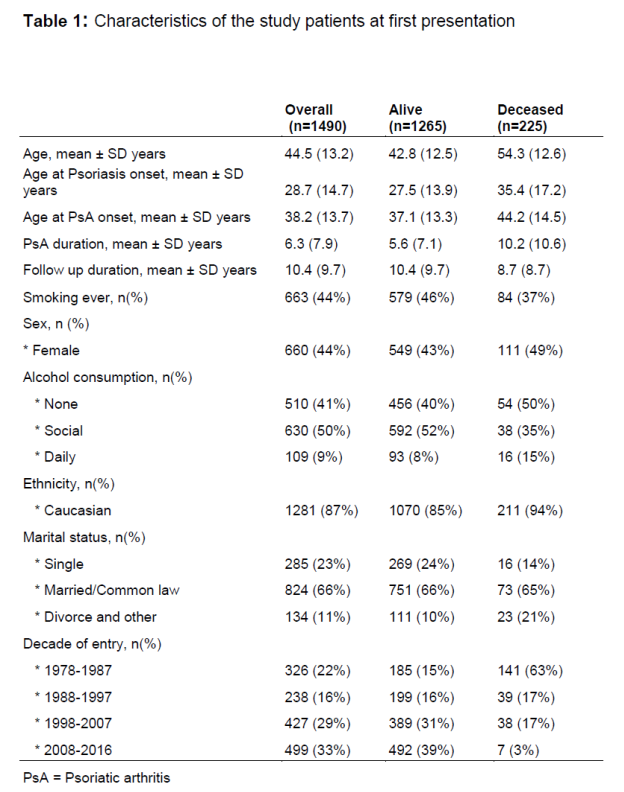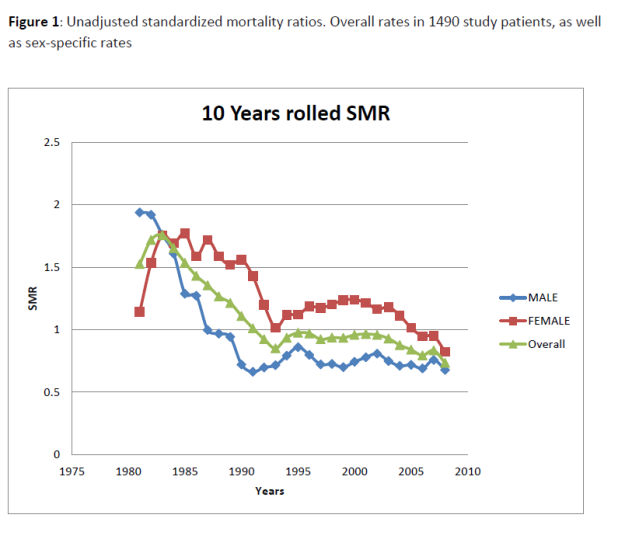Session Information
Date: Tuesday, October 23, 2018
Title: Epidemiology and Public Health Poster III: SLE, SSc, APS, PsA, and Other Rheumatic Diseases
Session Type: ACR Poster Session C
Session Time: 9:00AM-11:00AM
Background/Purpose:
Psoriatic arthritis (PsA) is an inflammatory musculoskeletal disease that affects about 30% of psoriasis patients, and can lead to significant joint damage and disability. Results from mortality studies are inconsistent. The aims of this study were: 1) to estimate the trends in mortality rates among PsA patients over calendar time 2) to estimate cause-specific mortality rates.
Methods:
Patients are evaluated at the initial clinic visit and subsequently every 6-12 months according to a standard protocol. The prospectively collected data are stored in a web-based database and include demographics, personal and family medical history, smoking and alcohol drinking habits, medications, skin and musculoskeletal disease activity, imaging, and laboratory findings. Information on patient deaths and causes of death was collected prospectively and through linkage with the provincial cancer and death registries, through telephone interviews and correspondence with family physicians and patients’ relatives, and through daily checks of death notices in the newspaper. Death certificates, and admission letters were used, where possible, to verify patient deaths and to identify the primary cause of death. Standardized mortality ratios (SMRs) were computed with reference to the Ontario population and were calculated overall, by age, and by sex. Causes of death were recorded by ICD9 and ICD10 codes. Cause-specific SMRs were also computed.
Results:
Among 1490 patients followed over 14675 patient-years, there were 225 (15%) confirmed deaths among 111 female and 114 male individuals. The overall standardized mortality ratio was 0.92 (95% confidence interval [CI] 0.81-1.05), the sex specific SMRs were 1.08 (95% CI 0.89-1.30) for females and 0.80 (95% CI 0.66-0.97) for males. The age-specific SMRs were of 3.36 (95% CI 1.61-6.18) for those 20-39 years of age, and 0.97 (95% CI 0.68-1.34), 0.88 (95% CI 0.73-1.06) and 0.86 (95% CI 0.66-1.11) for 40-59, 60-79 and above 80 years of age respectively. Major causes of death included malignant neoplasms (n=61; SMR=0.97 [95% CI 0.72-1.28]), acute myocardial infarction (n=32; SMR=1.11 [95% CI 0.74-1.58]), and pneumonia (n=14; SMR=2.46 [95% CI 1.27-4.31]).
Conclusion:
Although the overall SMR was similar to the general population, higher SMR was found among patients who were younger at presentation. Further analyses are needed to understand the mortality risk, effect of comorbidities, and the effect of therapies.
To cite this abstract in AMA style:
Elalouf O, Muntyanu A, Pereira D, Polachek A, Ye JY, Lee KA, Chandran V, Cook RJ, Gladman DD. Mortality Rates and Causes in Psoriatic Arthritis Patients [abstract]. Arthritis Rheumatol. 2018; 70 (suppl 9). https://acrabstracts.org/abstract/mortality-rates-and-causes-in-psoriatic-arthritis-patients/. Accessed .« Back to 2018 ACR/ARHP Annual Meeting
ACR Meeting Abstracts - https://acrabstracts.org/abstract/mortality-rates-and-causes-in-psoriatic-arthritis-patients/


